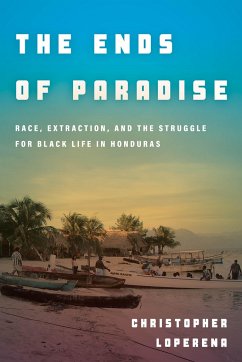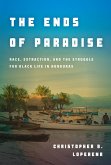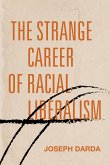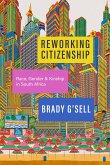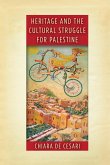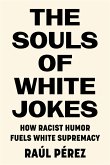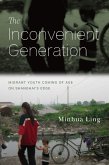Christopher Loperena
The Ends of Paradise
Race, Extraction, and the Struggle for Black Life in Honduras
Christopher Loperena
The Ends of Paradise
Race, Extraction, and the Struggle for Black Life in Honduras
- Gebundenes Buch
- Merkliste
- Auf die Merkliste
- Bewerten Bewerten
- Teilen
- Produkt teilen
- Produkterinnerung
- Produkterinnerung
"The future of Honduras begins and ends on the white sand beaches of Tela Bay on the country's northeastern coast where Garifuna, a Black Indigenous people, have resided for over 200 years. In "The Ends of Paradise," Christopher Loperena examines the Garifuna struggle for life and collective autonomy, and demonstrates how this struggle challenges concerted efforts by the state and multilateral institutions, such as the World Bank, to render both their lands and their culture into fungible tourism products. Using a combination of participant observation, courtroom ethnography, and archival…mehr
Andere Kunden interessierten sich auch für
![The Ends of Paradise The Ends of Paradise]() Christopher LoperenaThe Ends of Paradise28,99 €
Christopher LoperenaThe Ends of Paradise28,99 €![The Strange Career of Racial Liberalism The Strange Career of Racial Liberalism]() Joseph DardaThe Strange Career of Racial Liberalism26,99 €
Joseph DardaThe Strange Career of Racial Liberalism26,99 €![The News at the Ends of the Earth The News at the Ends of the Earth]() Hester BlumThe News at the Ends of the Earth38,99 €
Hester BlumThe News at the Ends of the Earth38,99 €![Reworking Citizenship Reworking Citizenship]() Brady G'sellReworking Citizenship34,99 €
Brady G'sellReworking Citizenship34,99 €![Heritage and the Cultural Struggle for Palestine Heritage and the Cultural Struggle for Palestine]() Chiara De CesariHeritage and the Cultural Struggle for Palestine125,99 €
Chiara De CesariHeritage and the Cultural Struggle for Palestine125,99 €![The Souls of White Jokes The Souls of White Jokes]() Raul PerezThe Souls of White Jokes20,99 €
Raul PerezThe Souls of White Jokes20,99 €![The Inconvenient Generation The Inconvenient Generation]() Minhua LingThe Inconvenient Generation125,99 €
Minhua LingThe Inconvenient Generation125,99 €-
-
-
"The future of Honduras begins and ends on the white sand beaches of Tela Bay on the country's northeastern coast where Garifuna, a Black Indigenous people, have resided for over 200 years. In "The Ends of Paradise," Christopher Loperena examines the Garifuna struggle for life and collective autonomy, and demonstrates how this struggle challenges concerted efforts by the state and multilateral institutions, such as the World Bank, to render both their lands and their culture into fungible tourism products. Using a combination of participant observation, courtroom ethnography, and archival research, Loperena reveals how purportedly inclusive tourism projects form part of a larger neoliberal, extractivist development regime, which remakes Black and Indigenous territories into frontiers of progress for the mestizo majority. The book offers a trenchant analysis of the ways Black dispossession and displacement are carried forth through the conferral of individual rights and freedoms, a prerequisite for resource exploitation under contemporary capitalism. By demanding to be accounted for on their terms, Garifuna anchor blackness to Central America--a place where Black peoples are presumed to be nonnative inhabitants--and to collective land rights. Steeped in Loperena's long term activist engagement with Garifuna land defenders, this book is a testament to their struggle and to the promise of "another world" in which Black and Indigenous peoples thrive"--
Hinweis: Dieser Artikel kann nur an eine deutsche Lieferadresse ausgeliefert werden.
Hinweis: Dieser Artikel kann nur an eine deutsche Lieferadresse ausgeliefert werden.
Produktdetails
- Produktdetails
- Verlag: Stanford University Press
- Seitenzahl: 232
- Erscheinungstermin: 15. November 2022
- Englisch
- Abmessung: 231mm x 150mm x 20mm
- Gewicht: 498g
- ISBN-13: 9781503632950
- ISBN-10: 1503632954
- Artikelnr.: 63936087
- Herstellerkennzeichnung
- Libri GmbH
- Europaallee 1
- 36244 Bad Hersfeld
- gpsr@libri.de
- Verlag: Stanford University Press
- Seitenzahl: 232
- Erscheinungstermin: 15. November 2022
- Englisch
- Abmessung: 231mm x 150mm x 20mm
- Gewicht: 498g
- ISBN-13: 9781503632950
- ISBN-10: 1503632954
- Artikelnr.: 63936087
- Herstellerkennzeichnung
- Libri GmbH
- Europaallee 1
- 36244 Bad Hersfeld
- gpsr@libri.de
Christopher A. Loperena is Associate Professor of Anthropology at the Graduate Center, City University of New York.
Contents and Abstracts
Introduction: Imagining Black Indigenous Futures
chapter abstract
The introduction establishes how Black and Indigenous struggles for
territorial autonomy in Honduras interact with larger social and economic
forces, including the global resurgence of resource extraction that is
slowly eroding the customary rights of Indigenous peoples across the
Americas. Although the government of Honduras has presented tourism as a
sustainable alternative to extractive industries, this chapter argues that
tourism is an extractivist enterprise premised on environmental
dispossession and racial violence against rural communities of color. It
also shows how Garifuna-a Black Indigenous people of African, Arawak, and
Carib descent-fight back against the extractivist mandate of the Honduran
state and multinational capital on the Caribbean Coast.
1The Extractivist Logics of Progress
chapter abstract
Chapter 1 traces the historical genealogy of extractivism in Honduras. From
the banana enclaves of the early twentieth century to sumptuous coastal
tourism resorts and the contemporary bid to establish semiautonomous
charter cities in purportedly unpopulated areas of the country, the state
has tried to enact various visions of progress. All these visions, though,
are intimately tethered to extractivism, particularly racial extractivism.
2The Garifuna Coast: The Inclusionary Politics of Expulsion
chapter abstract
Chapter 2 analyzes how the tourism economy facilitates racialized
extraction. The advent of multicultural rights unfolded alongside state
programs designed to transform Garifuna people into subjects of
development. But the inclusion of Black and Indigenous communities seems
inseparable from the commodification of those communities; the government's
policies all seem to render Garifuna lands and culture as tourism products.
These policies are presented as a win-win for everyone, equally beneficial
to Garifuna and working-class non-Indigenous Hondurans who remain stymied
by poverty and the legacy of "underdevelopment." The only clear winner is
not either one of these groups, but rather the mestizo elite. Garifuna
resistance to government policies exposes the inner workings of supposedly
inclusionary politics and how those efforts ultimately advance not
inclusion, but racial and spatial expulsion.
3Tensions of Autonomous Blackness
chapter abstract
Chapter 3 examines how statist development objectives seep into the lives
of Garifuna in Triunfo de la Cruz, Honduras. Neoliberal economic paradigms
emerged in tandem with morally saturated development discourses that tout
poverty reduction, inclusion, and sustainability, and also imagine Garifuna
as stakeholders with the capacity to benefit from and contribute
productively to Honduras's tourism economy. Policies that promote
participation in the tourism economy are entangled with contests over land
and belonging. Conflicts over the fate of the community figure prominently
in daily life, as community members-for and against government-sponsored
development-reckon with the dispossession that inevitably come with
development and debate how to negotiate with and when to protest against
these forces. Garifuna land defense strategies are articulated through the
practice of Black autonomy: an ethico-political proposal that refuses
dominant narratives of progress and instead asserts a notion of autonomy as
collective action and social good.
4Rescue the Land, Defend the Future
chapter abstract
Chapter 4 theorizes the spatial and temporal dimensions of Garifuna
political subjectivity through an analysis of the movement to recuperate or
"rescue" communal lands from privatization. The chapter examines how
Garifuna women lead the lucha (struggle) in defense of their territory with
their bodies, and how that defense is bound up with gendered narratives of
ancestrality and the praxis of territorial mothering. To live ancestrally
is a way of being in relation with the land, which is crucial to Garifuna
autonomy and a key feature of the struggle to contest the
destination-making strategies of multinational capital on the Caribbean
coast.
5The Limits of Indigeneity: Pueblo Garifuna v. Honduras
chapter abstract
Chapter 5 examines the public hearing at the Inter-American Court of Human
Rights of the Garifuna Community Triunfo de la Cruz and Its Members v.
Honduras. During court proceedings, Honduras's deputy attorney general
argued that Garifuna should not be considered an "original people"
(indigenous to Honduras) and thus Garifuna claims to national territory
were not legitimate. State officials not only undermined the possibility of
Black Indigeneity but also exalted the rights of officially recognized
Indigenous peoples to defend mestizo property rights in the zone. This
politics of (mis)recognition tethers Indigenous subjectivity to the mestizo
nation-building project and ideologies of whitening. It reinforces the
perception that Black people are foreigners in Honduras. The court's
judgment in favor of the community established an important legal precedent
for the recognition of Black territorial rights but also served to buttress
state sovereignty over natural resources deemed to be of "public use."
Conclusion: Conclusion
chapter abstract
The conclusion to this book begins with the violent murder of the
Indigenous activist Berta Cáceres. At the time of her death, Cáceres was
leading a daring community uprising against the development of a large
hydroelectric project slated to be built on the Gualcarque River in the
Lenca community of Río Blanco. Her death marked the beginning of a new wave
of repression against Indigenous and Black activists that reached its apex
on July 18, 2020, with the kidnapping of four community leaders in Triunfo
de la Cruz. This worrisome pattern demonstrates deep-seated racial animus
toward Black and Indigenous peoples and the rights they fought so hard to
obtain during the preceding decades. In spite of the devastating and racist
violence they face, Black and Indigenous peoples continue to mobilize in
defense of life.
chapter abstract
Introduction: Imagining Black Indigenous Futures
chapter abstract
The introduction establishes how Black and Indigenous struggles for
territorial autonomy in Honduras interact with larger social and economic
forces, including the global resurgence of resource extraction that is
slowly eroding the customary rights of Indigenous peoples across the
Americas. Although the government of Honduras has presented tourism as a
sustainable alternative to extractive industries, this chapter argues that
tourism is an extractivist enterprise premised on environmental
dispossession and racial violence against rural communities of color. It
also shows how Garifuna-a Black Indigenous people of African, Arawak, and
Carib descent-fight back against the extractivist mandate of the Honduran
state and multinational capital on the Caribbean Coast.
1The Extractivist Logics of Progress
chapter abstract
Chapter 1 traces the historical genealogy of extractivism in Honduras. From
the banana enclaves of the early twentieth century to sumptuous coastal
tourism resorts and the contemporary bid to establish semiautonomous
charter cities in purportedly unpopulated areas of the country, the state
has tried to enact various visions of progress. All these visions, though,
are intimately tethered to extractivism, particularly racial extractivism.
2The Garifuna Coast: The Inclusionary Politics of Expulsion
chapter abstract
Chapter 2 analyzes how the tourism economy facilitates racialized
extraction. The advent of multicultural rights unfolded alongside state
programs designed to transform Garifuna people into subjects of
development. But the inclusion of Black and Indigenous communities seems
inseparable from the commodification of those communities; the government's
policies all seem to render Garifuna lands and culture as tourism products.
These policies are presented as a win-win for everyone, equally beneficial
to Garifuna and working-class non-Indigenous Hondurans who remain stymied
by poverty and the legacy of "underdevelopment." The only clear winner is
not either one of these groups, but rather the mestizo elite. Garifuna
resistance to government policies exposes the inner workings of supposedly
inclusionary politics and how those efforts ultimately advance not
inclusion, but racial and spatial expulsion.
3Tensions of Autonomous Blackness
chapter abstract
Chapter 3 examines how statist development objectives seep into the lives
of Garifuna in Triunfo de la Cruz, Honduras. Neoliberal economic paradigms
emerged in tandem with morally saturated development discourses that tout
poverty reduction, inclusion, and sustainability, and also imagine Garifuna
as stakeholders with the capacity to benefit from and contribute
productively to Honduras's tourism economy. Policies that promote
participation in the tourism economy are entangled with contests over land
and belonging. Conflicts over the fate of the community figure prominently
in daily life, as community members-for and against government-sponsored
development-reckon with the dispossession that inevitably come with
development and debate how to negotiate with and when to protest against
these forces. Garifuna land defense strategies are articulated through the
practice of Black autonomy: an ethico-political proposal that refuses
dominant narratives of progress and instead asserts a notion of autonomy as
collective action and social good.
4Rescue the Land, Defend the Future
chapter abstract
Chapter 4 theorizes the spatial and temporal dimensions of Garifuna
political subjectivity through an analysis of the movement to recuperate or
"rescue" communal lands from privatization. The chapter examines how
Garifuna women lead the lucha (struggle) in defense of their territory with
their bodies, and how that defense is bound up with gendered narratives of
ancestrality and the praxis of territorial mothering. To live ancestrally
is a way of being in relation with the land, which is crucial to Garifuna
autonomy and a key feature of the struggle to contest the
destination-making strategies of multinational capital on the Caribbean
coast.
5The Limits of Indigeneity: Pueblo Garifuna v. Honduras
chapter abstract
Chapter 5 examines the public hearing at the Inter-American Court of Human
Rights of the Garifuna Community Triunfo de la Cruz and Its Members v.
Honduras. During court proceedings, Honduras's deputy attorney general
argued that Garifuna should not be considered an "original people"
(indigenous to Honduras) and thus Garifuna claims to national territory
were not legitimate. State officials not only undermined the possibility of
Black Indigeneity but also exalted the rights of officially recognized
Indigenous peoples to defend mestizo property rights in the zone. This
politics of (mis)recognition tethers Indigenous subjectivity to the mestizo
nation-building project and ideologies of whitening. It reinforces the
perception that Black people are foreigners in Honduras. The court's
judgment in favor of the community established an important legal precedent
for the recognition of Black territorial rights but also served to buttress
state sovereignty over natural resources deemed to be of "public use."
Conclusion: Conclusion
chapter abstract
The conclusion to this book begins with the violent murder of the
Indigenous activist Berta Cáceres. At the time of her death, Cáceres was
leading a daring community uprising against the development of a large
hydroelectric project slated to be built on the Gualcarque River in the
Lenca community of Río Blanco. Her death marked the beginning of a new wave
of repression against Indigenous and Black activists that reached its apex
on July 18, 2020, with the kidnapping of four community leaders in Triunfo
de la Cruz. This worrisome pattern demonstrates deep-seated racial animus
toward Black and Indigenous peoples and the rights they fought so hard to
obtain during the preceding decades. In spite of the devastating and racist
violence they face, Black and Indigenous peoples continue to mobilize in
defense of life.
chapter abstract
Contents and Abstracts
Introduction: Imagining Black Indigenous Futures
chapter abstract
The introduction establishes how Black and Indigenous struggles for
territorial autonomy in Honduras interact with larger social and economic
forces, including the global resurgence of resource extraction that is
slowly eroding the customary rights of Indigenous peoples across the
Americas. Although the government of Honduras has presented tourism as a
sustainable alternative to extractive industries, this chapter argues that
tourism is an extractivist enterprise premised on environmental
dispossession and racial violence against rural communities of color. It
also shows how Garifuna-a Black Indigenous people of African, Arawak, and
Carib descent-fight back against the extractivist mandate of the Honduran
state and multinational capital on the Caribbean Coast.
1The Extractivist Logics of Progress
chapter abstract
Chapter 1 traces the historical genealogy of extractivism in Honduras. From
the banana enclaves of the early twentieth century to sumptuous coastal
tourism resorts and the contemporary bid to establish semiautonomous
charter cities in purportedly unpopulated areas of the country, the state
has tried to enact various visions of progress. All these visions, though,
are intimately tethered to extractivism, particularly racial extractivism.
2The Garifuna Coast: The Inclusionary Politics of Expulsion
chapter abstract
Chapter 2 analyzes how the tourism economy facilitates racialized
extraction. The advent of multicultural rights unfolded alongside state
programs designed to transform Garifuna people into subjects of
development. But the inclusion of Black and Indigenous communities seems
inseparable from the commodification of those communities; the government's
policies all seem to render Garifuna lands and culture as tourism products.
These policies are presented as a win-win for everyone, equally beneficial
to Garifuna and working-class non-Indigenous Hondurans who remain stymied
by poverty and the legacy of "underdevelopment." The only clear winner is
not either one of these groups, but rather the mestizo elite. Garifuna
resistance to government policies exposes the inner workings of supposedly
inclusionary politics and how those efforts ultimately advance not
inclusion, but racial and spatial expulsion.
3Tensions of Autonomous Blackness
chapter abstract
Chapter 3 examines how statist development objectives seep into the lives
of Garifuna in Triunfo de la Cruz, Honduras. Neoliberal economic paradigms
emerged in tandem with morally saturated development discourses that tout
poverty reduction, inclusion, and sustainability, and also imagine Garifuna
as stakeholders with the capacity to benefit from and contribute
productively to Honduras's tourism economy. Policies that promote
participation in the tourism economy are entangled with contests over land
and belonging. Conflicts over the fate of the community figure prominently
in daily life, as community members-for and against government-sponsored
development-reckon with the dispossession that inevitably come with
development and debate how to negotiate with and when to protest against
these forces. Garifuna land defense strategies are articulated through the
practice of Black autonomy: an ethico-political proposal that refuses
dominant narratives of progress and instead asserts a notion of autonomy as
collective action and social good.
4Rescue the Land, Defend the Future
chapter abstract
Chapter 4 theorizes the spatial and temporal dimensions of Garifuna
political subjectivity through an analysis of the movement to recuperate or
"rescue" communal lands from privatization. The chapter examines how
Garifuna women lead the lucha (struggle) in defense of their territory with
their bodies, and how that defense is bound up with gendered narratives of
ancestrality and the praxis of territorial mothering. To live ancestrally
is a way of being in relation with the land, which is crucial to Garifuna
autonomy and a key feature of the struggle to contest the
destination-making strategies of multinational capital on the Caribbean
coast.
5The Limits of Indigeneity: Pueblo Garifuna v. Honduras
chapter abstract
Chapter 5 examines the public hearing at the Inter-American Court of Human
Rights of the Garifuna Community Triunfo de la Cruz and Its Members v.
Honduras. During court proceedings, Honduras's deputy attorney general
argued that Garifuna should not be considered an "original people"
(indigenous to Honduras) and thus Garifuna claims to national territory
were not legitimate. State officials not only undermined the possibility of
Black Indigeneity but also exalted the rights of officially recognized
Indigenous peoples to defend mestizo property rights in the zone. This
politics of (mis)recognition tethers Indigenous subjectivity to the mestizo
nation-building project and ideologies of whitening. It reinforces the
perception that Black people are foreigners in Honduras. The court's
judgment in favor of the community established an important legal precedent
for the recognition of Black territorial rights but also served to buttress
state sovereignty over natural resources deemed to be of "public use."
Conclusion: Conclusion
chapter abstract
The conclusion to this book begins with the violent murder of the
Indigenous activist Berta Cáceres. At the time of her death, Cáceres was
leading a daring community uprising against the development of a large
hydroelectric project slated to be built on the Gualcarque River in the
Lenca community of Río Blanco. Her death marked the beginning of a new wave
of repression against Indigenous and Black activists that reached its apex
on July 18, 2020, with the kidnapping of four community leaders in Triunfo
de la Cruz. This worrisome pattern demonstrates deep-seated racial animus
toward Black and Indigenous peoples and the rights they fought so hard to
obtain during the preceding decades. In spite of the devastating and racist
violence they face, Black and Indigenous peoples continue to mobilize in
defense of life.
chapter abstract
Introduction: Imagining Black Indigenous Futures
chapter abstract
The introduction establishes how Black and Indigenous struggles for
territorial autonomy in Honduras interact with larger social and economic
forces, including the global resurgence of resource extraction that is
slowly eroding the customary rights of Indigenous peoples across the
Americas. Although the government of Honduras has presented tourism as a
sustainable alternative to extractive industries, this chapter argues that
tourism is an extractivist enterprise premised on environmental
dispossession and racial violence against rural communities of color. It
also shows how Garifuna-a Black Indigenous people of African, Arawak, and
Carib descent-fight back against the extractivist mandate of the Honduran
state and multinational capital on the Caribbean Coast.
1The Extractivist Logics of Progress
chapter abstract
Chapter 1 traces the historical genealogy of extractivism in Honduras. From
the banana enclaves of the early twentieth century to sumptuous coastal
tourism resorts and the contemporary bid to establish semiautonomous
charter cities in purportedly unpopulated areas of the country, the state
has tried to enact various visions of progress. All these visions, though,
are intimately tethered to extractivism, particularly racial extractivism.
2The Garifuna Coast: The Inclusionary Politics of Expulsion
chapter abstract
Chapter 2 analyzes how the tourism economy facilitates racialized
extraction. The advent of multicultural rights unfolded alongside state
programs designed to transform Garifuna people into subjects of
development. But the inclusion of Black and Indigenous communities seems
inseparable from the commodification of those communities; the government's
policies all seem to render Garifuna lands and culture as tourism products.
These policies are presented as a win-win for everyone, equally beneficial
to Garifuna and working-class non-Indigenous Hondurans who remain stymied
by poverty and the legacy of "underdevelopment." The only clear winner is
not either one of these groups, but rather the mestizo elite. Garifuna
resistance to government policies exposes the inner workings of supposedly
inclusionary politics and how those efforts ultimately advance not
inclusion, but racial and spatial expulsion.
3Tensions of Autonomous Blackness
chapter abstract
Chapter 3 examines how statist development objectives seep into the lives
of Garifuna in Triunfo de la Cruz, Honduras. Neoliberal economic paradigms
emerged in tandem with morally saturated development discourses that tout
poverty reduction, inclusion, and sustainability, and also imagine Garifuna
as stakeholders with the capacity to benefit from and contribute
productively to Honduras's tourism economy. Policies that promote
participation in the tourism economy are entangled with contests over land
and belonging. Conflicts over the fate of the community figure prominently
in daily life, as community members-for and against government-sponsored
development-reckon with the dispossession that inevitably come with
development and debate how to negotiate with and when to protest against
these forces. Garifuna land defense strategies are articulated through the
practice of Black autonomy: an ethico-political proposal that refuses
dominant narratives of progress and instead asserts a notion of autonomy as
collective action and social good.
4Rescue the Land, Defend the Future
chapter abstract
Chapter 4 theorizes the spatial and temporal dimensions of Garifuna
political subjectivity through an analysis of the movement to recuperate or
"rescue" communal lands from privatization. The chapter examines how
Garifuna women lead the lucha (struggle) in defense of their territory with
their bodies, and how that defense is bound up with gendered narratives of
ancestrality and the praxis of territorial mothering. To live ancestrally
is a way of being in relation with the land, which is crucial to Garifuna
autonomy and a key feature of the struggle to contest the
destination-making strategies of multinational capital on the Caribbean
coast.
5The Limits of Indigeneity: Pueblo Garifuna v. Honduras
chapter abstract
Chapter 5 examines the public hearing at the Inter-American Court of Human
Rights of the Garifuna Community Triunfo de la Cruz and Its Members v.
Honduras. During court proceedings, Honduras's deputy attorney general
argued that Garifuna should not be considered an "original people"
(indigenous to Honduras) and thus Garifuna claims to national territory
were not legitimate. State officials not only undermined the possibility of
Black Indigeneity but also exalted the rights of officially recognized
Indigenous peoples to defend mestizo property rights in the zone. This
politics of (mis)recognition tethers Indigenous subjectivity to the mestizo
nation-building project and ideologies of whitening. It reinforces the
perception that Black people are foreigners in Honduras. The court's
judgment in favor of the community established an important legal precedent
for the recognition of Black territorial rights but also served to buttress
state sovereignty over natural resources deemed to be of "public use."
Conclusion: Conclusion
chapter abstract
The conclusion to this book begins with the violent murder of the
Indigenous activist Berta Cáceres. At the time of her death, Cáceres was
leading a daring community uprising against the development of a large
hydroelectric project slated to be built on the Gualcarque River in the
Lenca community of Río Blanco. Her death marked the beginning of a new wave
of repression against Indigenous and Black activists that reached its apex
on July 18, 2020, with the kidnapping of four community leaders in Triunfo
de la Cruz. This worrisome pattern demonstrates deep-seated racial animus
toward Black and Indigenous peoples and the rights they fought so hard to
obtain during the preceding decades. In spite of the devastating and racist
violence they face, Black and Indigenous peoples continue to mobilize in
defense of life.
chapter abstract

